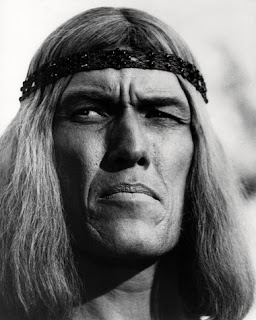Continuing an attempt to pulpify Tolkien's legendarium, let's take a look at the races other than Men.
Elves
Elves in Tolkien are superior to men in just about every way. Pulp fantasy has that sort of thing, too. Check out this quote regarding an ancient race from "Queen of the Black Coast":
“Cast in the mold of humanity, they were distinctly not men. . .in physical appearance they resembled man only as man in his highest form resembles the great apes. In spiritual, esthetic and intellectual development they were superior to man as man is superior to the gorilla.“Howard makes mention of "evolution" in several places. Sword & sorcery pulp worlds tend toward pseudo-science, as they partake of the genre-blending weird fiction tradition, whereas Tolkien's is a mythic world. For the complete pulp feel, The Silmarillion would be merely myth and the true origins of most Middle-earth creatures would be scientific/materialistic--or perhaps some Theosophy-inspired mix of science and mysticism. No need to make a decision one way or another, though, for day to day adventuring.
"Do you not see now that your coming to us is as the footstep of Doom? For if you fail, then we are laid bare to the Enemy. Yet if you succeed, then our power is diminished, and Lothlórien will fade, and the tides of Time will sweep it away. We must depart into the West, or dwindle to a rustic folk of dell and cave, slowly to forget and be forgotten."
- Galadriel in The Fellowship of the RingDecline of advanced races/cultures is a trope common to Tolkien and Howard, so good to go. The decline to "rustic folk of dell and cave" even kind of resembles the decline of the Picts as presented in "The Lost Race." Lord of the Rings is full of a lot of elvish badassery (the movies moreso) but the more that is downplayed and the more their waning and decline is played up, the more pulp fantasy it will be. Elves can still be a potent force, but they should mostly stay in their dwindling enclaves.
Orcs
Other Howard stories present Picts as not just declining but degenerating. The same thing happens to the Winged Folk in "Queen of the Black Coasts" who become winged ape men by the time Conan meets them. One of several origins Tolkien considers for Orcs is that they are elves distorted and corrupted by Melkor. Perhaps the corrupted part is the main thing, then they sort of degenerate on their own?
In fact, there should be more evil, degenerate elves in general; the equivalent of the Black Numenoreans. I don't want to say, "drow," but Gary's description of Erelhei-Cinlu in Vault of the Drow is pretty pulpy.























